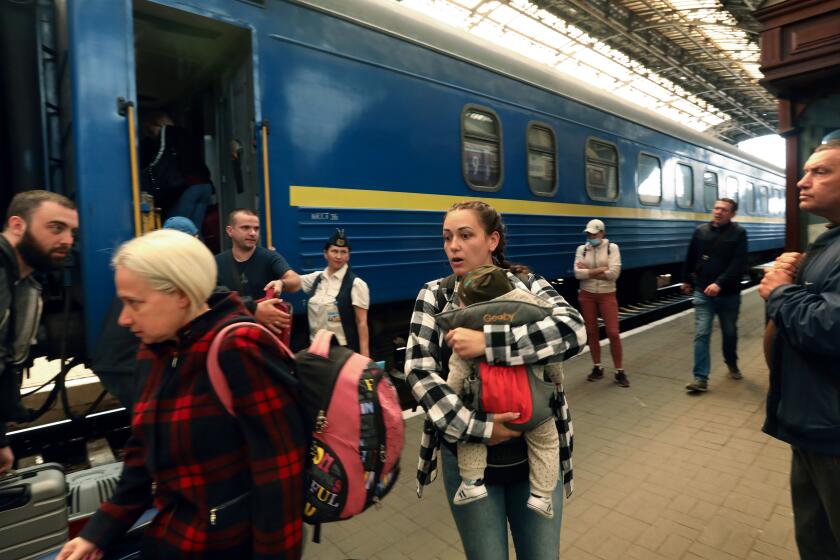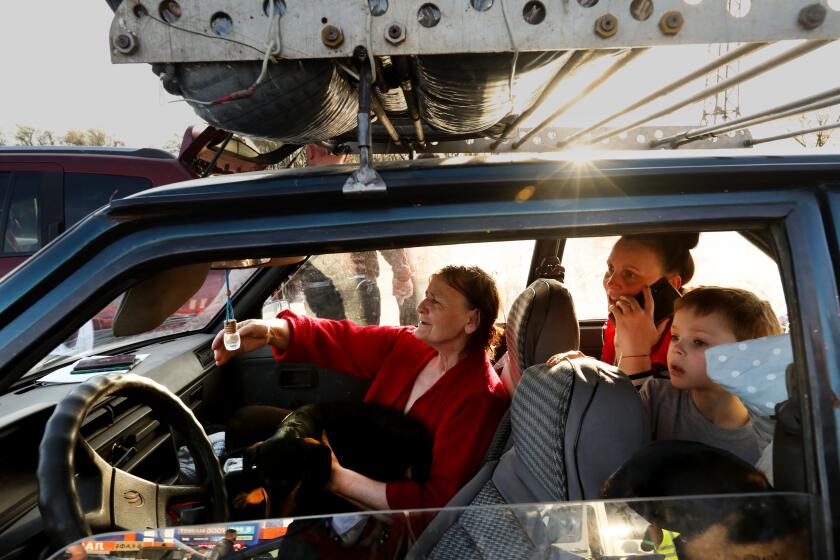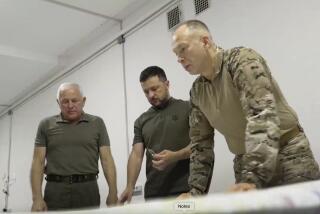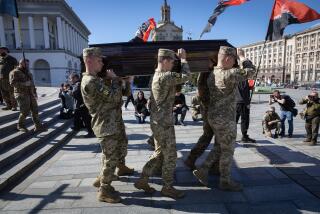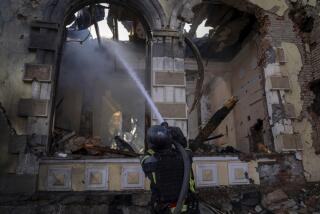New bid to rescue Mariupol civilians as Russia tries to complete takeover of port city
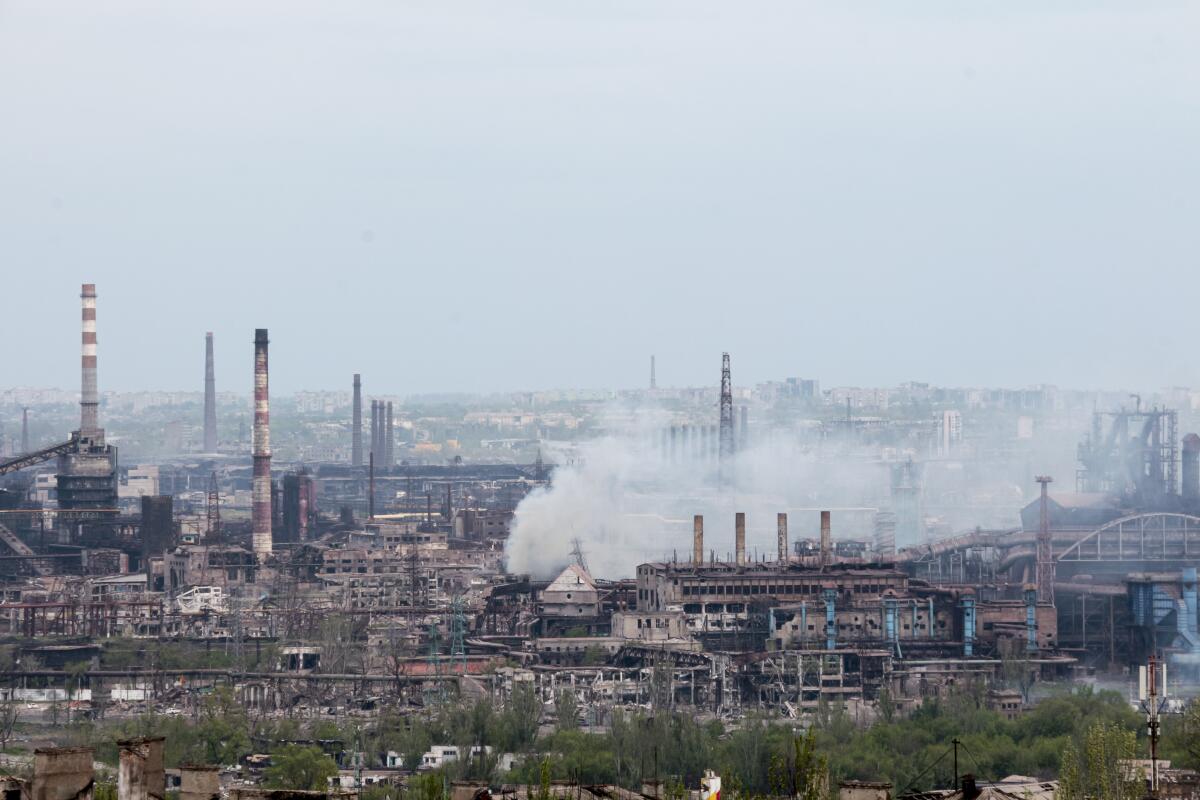
- Share via
KYIV, Ukraine — Dozens of civilians were pulled to safety Friday from the besieged Azovstal steel plant, where Ukrainian soldiers sheltering in a maze of underground tunnels have prevented Russian forces from fully capturing the strategic port city of Mariupol.
As a furious bid was underway to rescue hundreds of Mariupol residents trapped inside the sprawling Soviet-era complex, Ukrainian President Volodymyr Zelensky accused Russia of “torturing to death” those still inside.
Later, Ukrainian Deputy Prime Minister Iryna Vereshchuk said in a statement that evacuation efforts were slow because of “fights and other provocations.”
“The enemy was constantly violating the cease-fire,” Vereshchuk said.
But at least 50 women, children and elderly people were rescued from the massive building, and Vereshchuk held out hopes of evacuating a few more.
“Hang in there!” she told those left behind, noting the effort would resume Saturday.
The rescue attempt — the third of its kind in the last week by the United Nations and the International Committee of the Red Cross — comes amid renewed ground assaults on the massive steel plant by Russian troops, despite earlier pledges that they would only seal it off.
At the same time, fighting continued in eastern Ukraine, where the Kremlin’s forces have redoubled their efforts to capture the Donbas region, home to many ethnic Russians. Ukraine has battled against pro-Russia separatists in the area for eight years, and there are signs that Ukrainian soldiers are mounting a successful counteroffensive to push back Russian troops from around the key city of Kharkiv.
According to the Washington-based Institute for the Study of War’s latest assessment, Ukrainian troops stretching over a broad arc north and east of Kharkiv secured further settlements in the last 24 hours and could push Russians out of artillery range of the city in the next few days.
Meanwhile, the report said, Russian forces made no progress on the Izyum axis, about 70 miles southeast, and probably secured only minor gains on the outskirts of the eastern town of Severodonetsk.
The attacks on the Mariupol steel plant are believed to be intensifying in order to subdue the last remnant of armed resistance in the southern city before Monday’s Victory Day celebrations in Russia marking the Soviet Union’s defeat of Nazi Germany in World War II. The annual patriotic event is highlighted by a military parade in Moscow’s Red Square and other cities, and the fall of Mariupol would give Russian President Vladimir Putin a symbolic victory at a time when most Western allies are uniting behind Ukraine.
Relieved but anxious and fearful, passengers on a Ukrainian train describe the horrors of the Russian invasion and recount what they left behind.
In the latest show of such support, First Lady Jill Biden left the U.S. for a trip to Romania and Slovakia to visit American troops and meet with Ukrainian refugees, whose ranks have swelled to more than 5.7 million since Russia invaded.
“It’s so important to the president and to me that the Ukrainian people know that we stand with them,” the first lady told reporters before departing.
The White House announced that President Biden will attend a virtual meeting with Zelensky and leaders from the Group of 7 countries on Sunday, a day ahead of Russia’s military parade.
“Having this meeting and conversation on Sunday is an opportunity to not only show how unified the West is in confronting the aggression and the invasion by President Putin, but also to show that unity requires work,” Jen Psaki, White House press secretary, said aboard Air Force One.
Meanwhile, a new human rights report cited “compelling” evidence of atrocities against Ukrainian civilians by Russian troops when a region near the capital, Kyiv, was occupied during roughly the first month of the war. Amnesty International, in a report Friday, cited proof of abuses including execution-style killings and torture. Despite a trail of mutilated bodies left behind, Russia has claimed that evidence uncovered by international investigators is phony.
In a visit to the Russian-occupied city of Kherson in the south of Ukraine, Andrei Turchak, a senior official in the pro-Kremlin United Russia party, told residents that “Russia is here forever.”
“There should be no doubt about this,” he added. “There will be no return to the past.”
At an online forum on Friday, Zelensky showed little willingness to cede land. When it came to ending the war, he suggested that nothing less than return of territory previously seized by Russia — Crimea and two separatist statelets in the east — would suffice.
“I was elected as president of Ukraine, not as president of mini-Ukraine,” he said at a forum by the British think tank Chatham House.
And without mentioning Putin by name, he telegraphed scorn for the Russian president.
“I do not care what happens to some leaders and where they end up,” he said. “For me, what matters is Ukraine’s victory.”
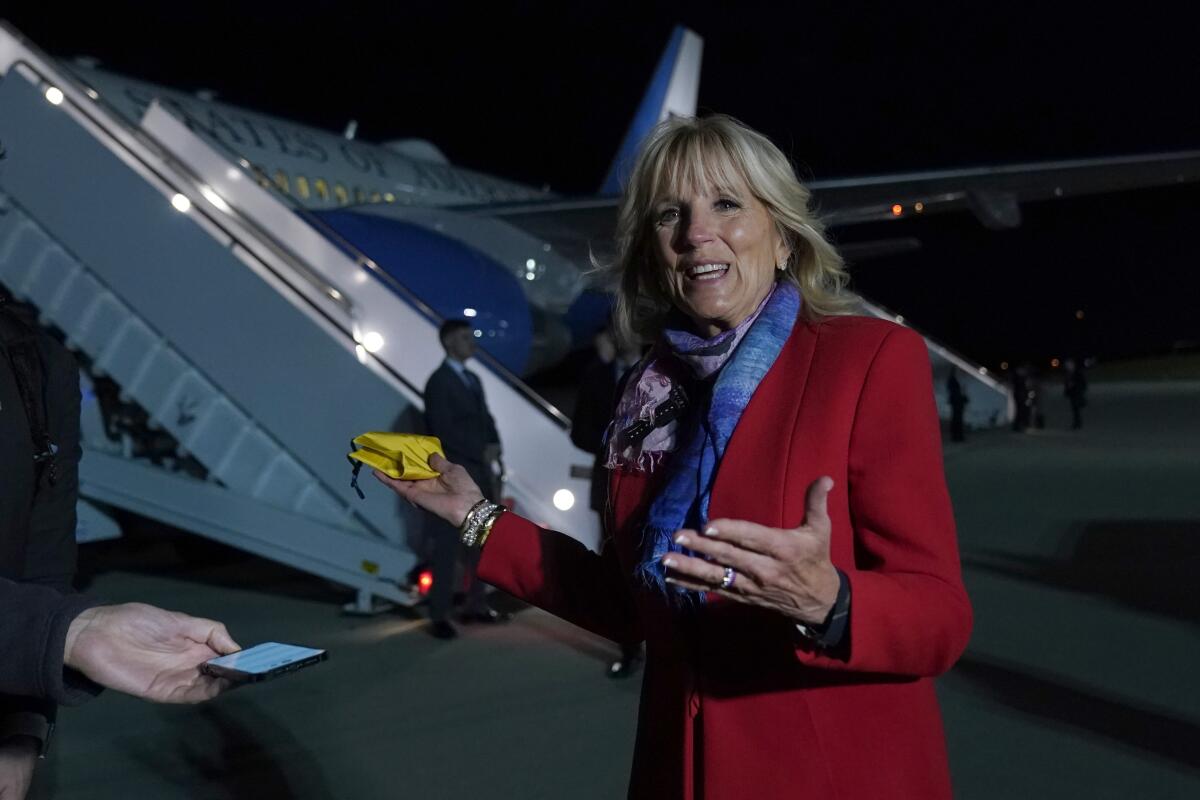
On Friday, the Biden administration announced a fresh package of $150 million in security assistance to Ukraine to fund artillery munitions, radars and other equipment.
“The United States has provided a historic amount of security assistance to Ukraine at rapid speed,” Biden said in a statement.
However, he noted that his administration has nearly exhausted funding that can be used to send security assistance to Ukraine and urged Congress to move quickly to pass his request for an additional $33 billion.
Noting that the last few weeks had highlighted the “intensity of conventional conflicts” in the 21st century, William A. LaPlante, undersecretary of Defense for acquisition and sustainment, told reporters at a news briefing that the Defense Department had transferred nearly a third of the $3.5-billion funding approved by Congress in the Ukraine supplemental aid package to replenish stocks of Javelin and Stinger missiles.
In addition, the Defense Department would spend $17.8 million to produce and send Switchblade drones to Ukraine as part of the $300-million Ukraine Security Assistance Initiative funding passed in March, LaPlante said. Already, he said, the department has awarded $136.8 million to send unmanned aerial systems, tanks, advanced precision kill weapon systems, combat medical equipment and ready-to-eat meals to Ukraine.
The Western response to the war has been relatively unified, but a fresh crack appeared Friday when Hungarian Prime Minister Viktor Orban said his country could not support a European Union proposal to ban Russian oil imports. Hungary, an EU member since 2004, relies on Russia for two-thirds of its oil supplies.
Orban said an embargo would be tantamount to dropping an “atomic bomb” on Hungary’s economy. Slovakia, which is also heavily dependent on Russian oil, has also expressed reservations.
With Ukraine pleading for more military aid, Germany confirmed that it would send seven of its most advanced self-propelled howitzers — massive artillery guns mounted on tracked armored vehicles. The assistance comes after Germany last week lifted its policy of not sending heavy weapons to conflict zones after growing calls to do more to help Ukraine’s defense.
After staying behind as long as they dare, residents who decide to flee besieged Mariupol find that a long and nerve-racking ordeal awaits.
Ukraine desperately needs the West to maintain pressure on Moscow now that fighting is concentrated in the east, where Russian forces and Russia-backed separatists aim to widen their hold after their failure to capture Kyiv.
On Thursday, a U.S. official told reporters that Washington has been sharing intelligence with Ukraine, including information that ultimately led to the sinking of the Moskva, a Russian missile cruiser struck and sunk in the Black Sea last month.
But Pentagon spokesman John Kirby emphasized in a subsequent statement that the United States did not have prior knowledge of the strike on the vessel, the flagship of Russia’s Black Sea fleet.
Russia’s Defense Ministry said Friday that its forces destroyed a Ukrainian ammunition depot in the city of Kramatorsk and that its air defenses downed two Ukrainian warplanes in the Luhansk region in the Donbas. The claims could not be independently verified.
Air-raid sirens sounded in Kyiv on Friday afternoon and again in the early evening. The capital region, which had braced for an assault by a column of Russian tanks in the opening weeks of the war, has largely been spared attack recently.
Mayor Vitali Klitschko took to the messaging app Telegram on Friday to warn against public gatherings in the city over the weekend, in advance of the Russian holiday. Municipal authorities stopped short of a tighter curfew but reminded residents that mass events are prohibited.
Start your day right
Sign up for Essential California for the L.A. Times biggest news, features and recommendations in your inbox six days a week.
You may occasionally receive promotional content from the Los Angeles Times.
Mariupol has been the focus of close attention because its capture would allow Russia to link its forces in the northeast and southeast and would help establish a land corridor along the southern coast to the Crimean peninsula, which Moscow illegally annexed in 2014. Russian control of Mariupol’s port would also choke off Ukraine’s access to the Sea of Azov, an important shipping hub.
Relentless shelling has created a humanitarian disaster in the city, but nearly 500 civilians were rescued in two evacuations in the last week, according to U.N. Secretary-General António Guterres.
As many as 2,000 Ukrainian soldiers are believed to still be beneath the Azovstal complex, which has been pummeled by Russian munitions.
Despite dwindling food and ammunition, the defenders remain determined to continue fighting.
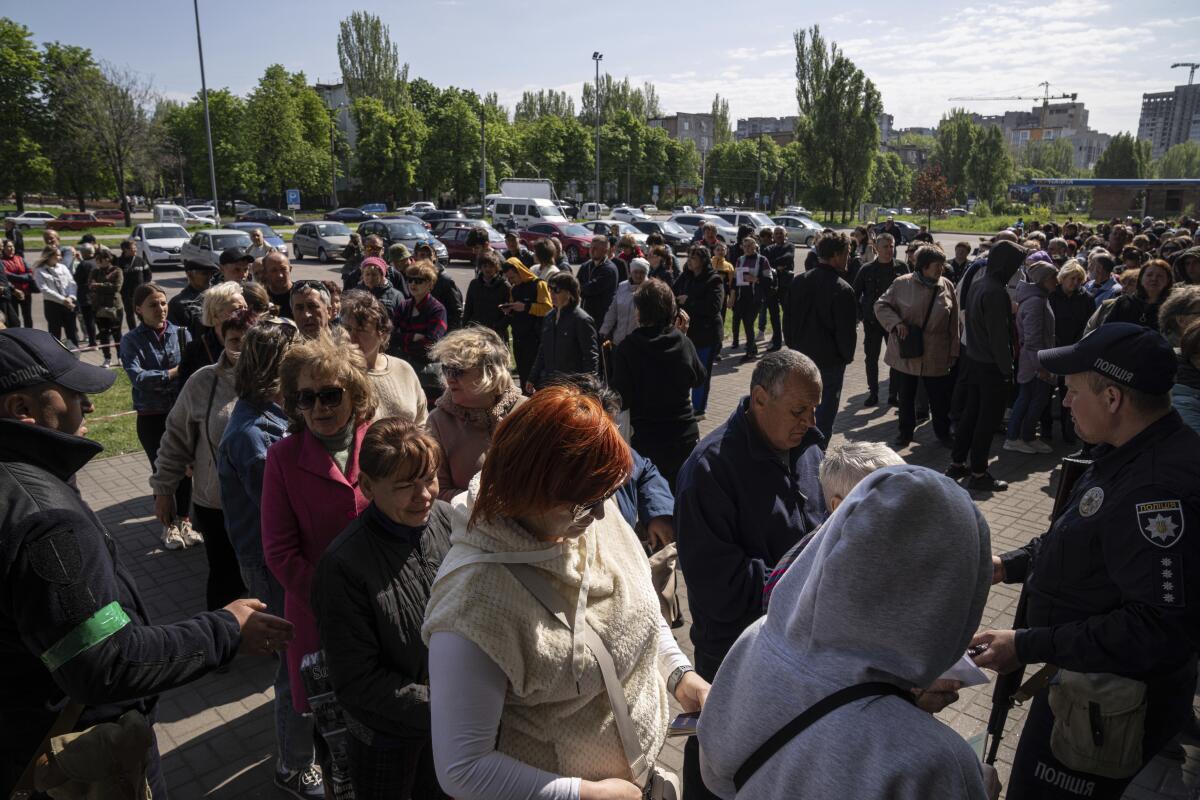
“They won’t surrender,” Kateryna Prokopenko, the wife of a Ukrainian commander at the site, told the Associated Press. “They only hope for a miracle.”
Zelensky, speaking Friday to Chatham House, said of Mariupol: “The entire city has been destroyed.”
Russia has denied entering the steel plant and says the refusal by Ukrainian soldiers to surrender is endangering the lives of the remaining civilians.
Ukrainian officials say Russian troops gained access to the plant with the help of an electrician who knew the layout of the factory complex.
“He showed them the underground tunnels, which are leading to the factory,” Anton Gerashchenko, an advisor to Ukraine’s Internal Affairs Ministry, said in a video posted Wednesday, according to the Associated Press. “Yesterday, the Russians started storming these tunnels, using the information they received from the betrayer.”
King reported from Kyiv, Pierson from Singapore and Jarvie from Atlanta. Times staff writer Eli Stokols in Washington contributed to this report.
More to Read
Sign up for Essential California
The most important California stories and recommendations in your inbox every morning.
You may occasionally receive promotional content from the Los Angeles Times.
